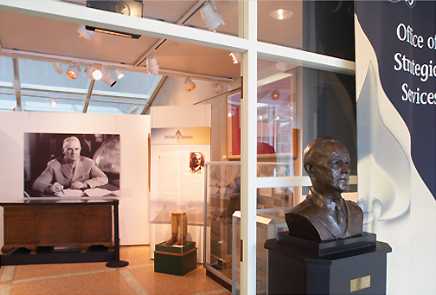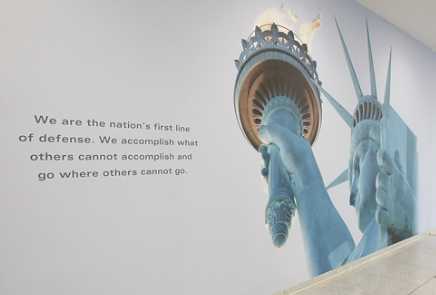About the CIA Museum
The CIA Museum was established in 1988 to give employees a sense of the unique history of their profession. This collection focuses on the CIA’s World War II predecessor, the Office of Strategic Services, to the present-day CIA.
Galleries
Office of Strategic Service Gallery
The OSS Gallery features the personal effects reflecting the career of Maj. Gen. William J. Donovan, the head of OSS, as well as numerous examples of OSS tradecraft (much of which was used by CIA after it was established by President Truman in 1947), to items from the Persian Gulf War and the end of the Cold War.
Cold War Gallery
The Cold War Gallery is located near the Original Headquarters Building main lobby. The staff of the Center for the Study of Intelligence, working in collaboration with collector and historian H. Keith Melton, established this exhibit in 1997 as part of the CIA’s 50th Anniversary celebration. “The Cold War: Fifty Years of Silent Conflict” exhibit showcases some of Melton’s 6,000 clandestine espionage artifacts from the United States, the former Soviet Union, and East Germany. These artifacts are currently on loan by Melton.
Directorate of Intelligence Gallery
For over 50 years the Directorate of Intelligence (DI) has informed US presidents and other policymakers about the world in which they live. DI analysts have evaluated “raw” information relating to national security and turned it into “finished” intelligence, from current to long-range, written as brief reports or as in-depth studies. The DI has covered crises and confrontations, produced timely insights available nowhere else, and put them into the right hands. In November 2002, the DI and the CIA Museum opened the only exhibit on intelligence analysis in the country to commemorate the DI’s 50th anniversary. Some of the unique items displayed include Francis Gary Powers’ U-2 model and an al-Qa’ida training manual.
Directorate of Science & Technology Gallery
Among the nation’s greatest secrets are those involving the CIA men and women who apply their skills and expertise in pure science, applied engineering, master craftsmanship, operational tradecraft, and linguistics to provide America’s leaders with critically important intelligence on the world. “The Directorate of Science & Technology — People & Technology In the Service of Freedom” commemorates the 40th Anniversary of the DS&T and provides a glimpse into this secret world. The items displayed here were designed by some of America’s most advanced thinkers, adapting existing technologies or inventing new ones — selflessly putting themselves in the service of freedom.
Afghan Gallery
In the aftermath of the Sept. 11, 2001 terrorist attacks, the President of the United States ordered the Director of Central Intelligence (DCI) to launch a operations against the al-Qa’ida terrorist organization and its Taliban supporters in Afghanistan. This order called for unilateral CIA operations to collect real-time, actionable intelligence to help shape the battlefield and to use all means to find and destroy al-Qa’ida. Within 15 days of the attacks on US soil, the first team of CIA officers was on the ground and operating in Afghanistan.
CIA teams blended diverse talents and highly experienced leaders who excelled in missions demanding independence, skill, initiative, and bravery. Operations officers, paramilitary officers, medics, field communications specialists, logistics officers, aircrews, firearms instructors, cartographers, computer technicians, analysts, reports officers, translators, and security officers were assembled by mission and operated as a flexible network that could accommodate varying geographic, tribal, and tactical conditions.
The combined efforts of US intelligence, US military forces, Afghan allies, and coalition partners formed the cornerstone of success in Afghanistan. In the ongoing Global War on Terror, all tools of US Intelligence will be directed toward defeating this global threat. CIA will continue to seek the right people to carry the battle to the enemy wherever they try to hide.
Through the exemplars of OSS and Operation Enduring Freedom unconventional warfare tradecraft and technologies, “On the Front Lines: The CIA in Afghanistan” presents artifacts and images relating to the global offensive against international terrorism. The uniquely visual exhibit addresses the importance of joint operations, cross-community relationships, and sacrifice while providing a current-mission focus in support of operational, training, and recruiting outreach.


